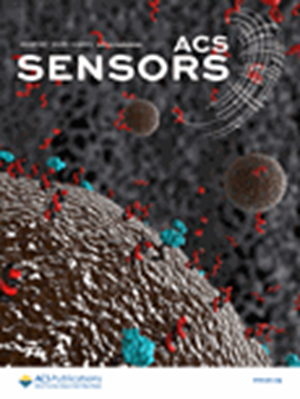CsPbBr3 量子点修饰的 In2O3 纳米纤维可在室温紫外线照射下有效检测 ppb 级 HCHO
IF 8.2
1区 化学
Q1 CHEMISTRY, ANALYTICAL
引用次数: 0
摘要
设计高性能、低功耗的甲醛(HCHO)气体传感器是研究人员在环境监测和人类健康方面非常感兴趣的问题。本文通过电纺丝和自组装方法成功合成了 In2O3/CsPbBr3 复合材料,并研究了其紫外激活(UV-activated)HCHO 气体传感性能。测量数据表明,In2O3/CsPbBr3 传感器对 HCHO 具有极佳的选择性。In2O3/CsPbBr3 传感器对 2ppm HCHO 的响应为 31.4,几乎是 In2O3 单独传感器的 11 倍。此外,In2O3/CsPbBr3 传感器还显示出卓越的线性度(R2 = 0.9696)、稳定的可逆性和理想的耐湿性。有趣的是,在紫外线照射下,In2O3/CsPbBr3 传感器的气体传感性能得到了进一步改善(Ra/Rg = 54.8)。HCHO 传感性能的改善可能归功于 In2O3 纳米纤维的独特结构、溴化铯铅量子点(CsPbBr3 QDs)对紫外光的吸附能力以及各组分之间异质结构的协同效应。研究采用密度泛函理论(DFT)讨论了 In2O3/CsPbBr3 复合材料表面对 HCHO 的吸附能力和电子特性。特别是,这项研究为利用紫外光改进气体传感材料指出了新的建设性思路。本文章由计算机程序翻译,如有差异,请以英文原文为准。

CsPbBr3 Quantum Dot Modified In2O3 Nanofibers for Effective Detection of ppb-Level HCHO at Room Temperature under UV Illumination
The design of high-performance and low-power formaldehyde (HCHO) gas sensors is of great interest to researchers for environmental monitoring and human health. Herein, In2O3/CsPbBr3 composites were successfully synthesized through an electrospinning and self-assembly approach, and their ultraviolet-activated (UV-activated) HCHO gas-sensing properties were investigated. The measurement data indicated that the In2O3/CsPbBr3 sensor possesses an excellent selectivity toward HCHO. The response of the In2O3/CsPbBr3 sensor to 2 ppm of HCHO was 31.4, which was almost 11 times larger than that of In2O3 alone. Besides, the In2O3/CsPbBr3 sensor also displayed extraordinary linearity (R2 = 0.9696), stable reversibility, and ideal humidity resistance. Interestingly, the gas-sensing properties of the In2O3/CsPbBr3 sensor were further improved (Ra/Rg = 54.8) under UV light irradiation. Meanwhile, the response/recovery time was shortened to 7/9 s. The improvement of HCHO-sensing properties might be ascribed to the distinctive structure of In2O3 nanofibers, the adsorption capacity of cesium lead bromide quantum dots (CsPbBr3 QDs) for UV light, and the synergistic effect of heterostructures between the components. Density functional theory (DFT) was implemented to discuss the adsorption ability and electronic characteristics of HCHO at the surface of In2O3/CsPbBr3 composites. Especially, this research points out new constructive thoughts for the exploitation of UV light improved gas-sensing materials.
求助全文
通过发布文献求助,成功后即可免费获取论文全文。
去求助
来源期刊

ACS Sensors
Chemical Engineering-Bioengineering
CiteScore
14.50
自引率
3.40%
发文量
372
期刊介绍:
ACS Sensors is a peer-reviewed research journal that focuses on the dissemination of new and original knowledge in the field of sensor science, particularly those that selectively sense chemical or biological species or processes. The journal covers a broad range of topics, including but not limited to biosensors, chemical sensors, gas sensors, intracellular sensors, single molecule sensors, cell chips, and microfluidic devices. It aims to publish articles that address conceptual advances in sensing technology applicable to various types of analytes or application papers that report on the use of existing sensing concepts in new ways or for new analytes.
 求助内容:
求助内容: 应助结果提醒方式:
应助结果提醒方式:


